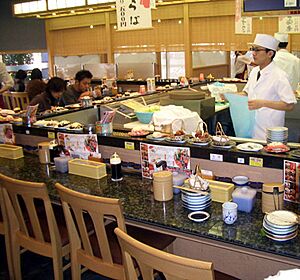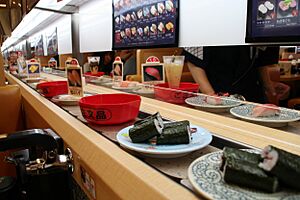Conveyor belt sushi facts for kids
Conveyor belt sushi (Japanese: 回転寿司, Hepburn: kaiten-zushi), also known as rotation sushi, is a fun type of sushi restaurant that started in Japan. In places like Australia and New Zealand, people often call it a sushi train.
In these restaurants, plates of sushi are placed on a moving conveyor belt. This belt winds its way through the restaurant, passing by every table and seat. When you're done eating, your bill is figured out by counting the number and types of plates you took. Some places even use cool variations, like tiny wooden "sushi boats" floating in small canals or miniature train cars carrying food on a track!
Contents
How Conveyor Belt Sushi Works
The main thing that makes conveyor belt sushi unique is the steady stream of plates moving around the restaurant. You can usually find more than just sushi on the belt. There might also be karaage (fried chicken), edamame (soybeans), salads, soups, fruits, and desserts.
Some restaurants use special RFID tags or other systems. These help them know if a sushi plate has been going around for too long. This way, they can remove older plates to make sure the food is always fresh.
Ordering Special Dishes
If you can't find the sushi or dish you want on the belt, you can usually order it specially. Some restaurants have speaker phones above the belt for this. Newer places might use a touchscreen or tablet to let you place your order.
When you order a small amount of food, it might be placed on the main conveyor belt. But don't worry, it will be marked so other customers know it's a special order for someone else! Often, it sits on a special stand. Some restaurants even have a second, faster belt just for special orders. Or, an automated tray might deliver your food right to your seat! If you order a lot, a staff member might bring it to you directly.
You'll find many useful things right at your seat. These include pickled ginger, chopsticks, soy sauce, and small dishes for your soy sauce. Wasabi might be on the belt or at your table. Most places offer free tea and ice water. You can usually find cups stacked above the belt and green tea powder or teabags on the table. There's also a hot water faucet at the tables to make your own tea.
Paying for Your Meal
Your bill is calculated by counting the number and types of plates you've eaten. Plates with different colors, patterns, or shapes usually have different prices. For example, a plain plate might be cheaper than a fancy gold-colored one. The cost of each plate is usually shown on signs or posters in the restaurant.
In Japan, prices often range from 100 yen to 500 yen. In Iceland, it might be 250 to 480 krónur. Some chains, like Kappa Sushi, have a fixed price of 100 yen for every plate. This is similar to 100-yen shops, where everything costs 100 yen.
When you're ready to pay, you can press a button to call a staff member. They will count your plates. Some modern restaurants have machines where you drop your plates to be counted automatically. Others use plates with RFID tags, which can be quickly scanned to get your total.
How the Conveyor Belt Works
The conveyor belt used for sushi is thin and narrow. It's designed to fit well in the smaller spaces of a sushi restaurant. Almost all sushi conveyors made in Japan come from Ishikawa Prefecture.
These conveyors often use a special plastic chain with crescent-shaped tops. This design allows the belt to make very tight turns, which is perfect for the winding paths in most conveyor belt sushi restaurants. This special design also means the conveyor can be very shallow, saving space.
Newer conveyor systems are even quieter and offer more freedom in restaurant design. Some have multiple levels to display more sushi in small areas. There are also high-speed lanes for delivering custom orders quickly!
History of Conveyor Belt Sushi
Conveyor belt sushi was invented by Yoshiaki Shiraishi (1914–2001). He owned a small sushi restaurant and found it hard to manage everything by himself, especially with staffing issues. He got the idea after watching beer bottles move along a conveyor belt at an Asahi brewery.
After five years of working on the design, Shiraishi opened the first conveyor belt sushi restaurant. It was called Mawaru Genroku Sushi and opened in Higashiosaka in 1958. His idea became very popular, and he eventually had about 250 restaurants across Japan. However, by 2001, his company had only 11 restaurants left. Shiraishi also tried to invent "robotic sushi" served by robots, but it wasn't very successful.
When conveyor belt sushi first started, all customers sat facing the belt. But this wasn't great for groups of people. So, restaurants later added tables that were at right angles to the belt. This allowed up to six people to sit together and also meant less conveyor belt was needed to serve everyone.
Conveyor belt sushi became very popular after a restaurant served sushi at the Osaka World Expo in 1970. Another big boom happened in the 1980s as eating out became more common. Then, in the late 1990s, inexpensive restaurants became popular after an economic downturn, leading to another surge in conveyor belt sushi's popularity. By 2010, Akindo Sushiro was one of the most famous conveyor belt sushi brands in Japan.
Images for kids
See also
 In Spanish: Kaitenzushi para niños
In Spanish: Kaitenzushi para niños






